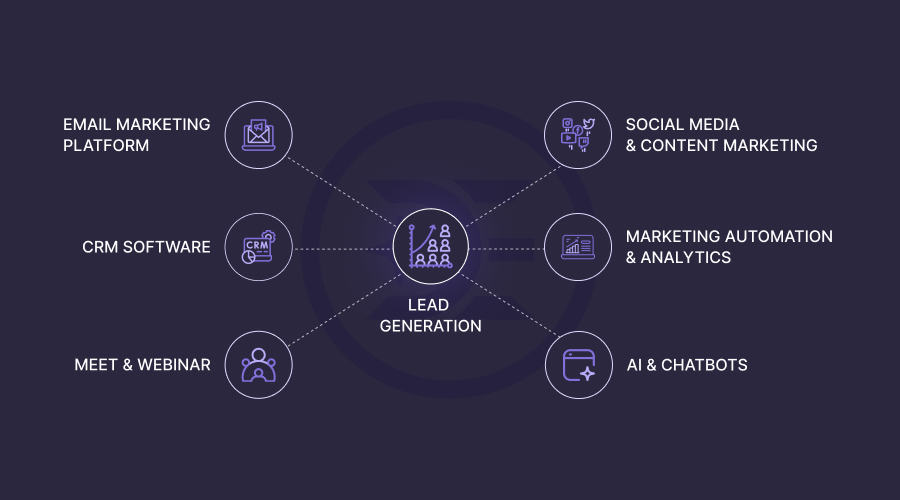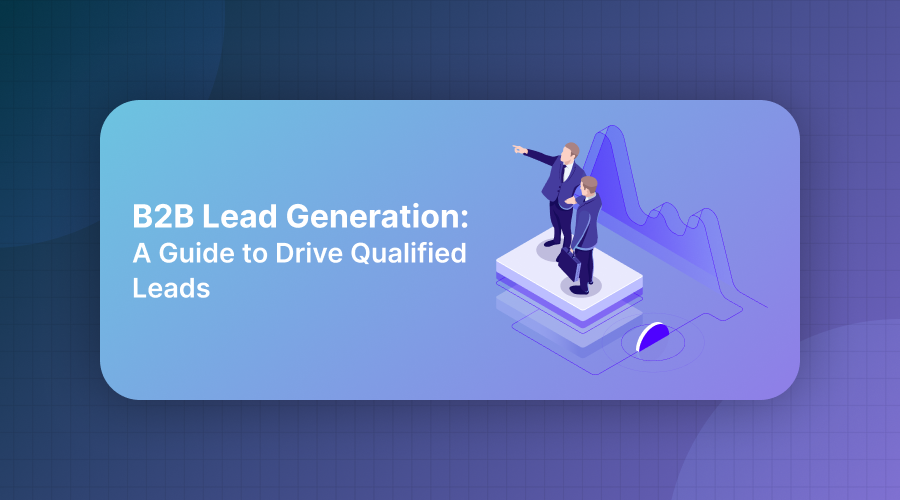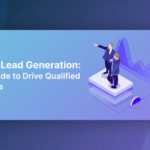What is B2B Lead Generation?
B2B lead generation is the process of identifying potential business clients who are likely to benefit from your products or services and guiding them through the journey from awareness to conversion. Unlike B2C, B2B leads involve multiple decision-makers, longer sales cycles, and often require more personalized engagement.
It’s a combination of marketing strategies, sales techniques, and technology tools aimed at driving high-quality, qualified leads that have the potential to convert into paying customers.
Key Components:
- Lead Identification: Understanding which businesses fit your Ideal Customer Profile (ICP).
- Lead Attraction: Using strategies like content marketing, social media, and SEO.
- Lead Qualification: Filtering leads based on intent, engagement, and budget.
- Lead Nurturing: Building relationships via personalized communication.
- Lead Conversion: Turning prospects into paying customers.
Why B2B Lead Generation is Important
B2B lead generation is the backbone of a sustainable sales pipeline. Here’s why it matters:
- Business Growth: Generating quality leads ensures a steady stream of potential customers.
- Cost Efficiency: Targeted campaigns reduce wasted marketing spend.
- Better Sales Forecasting: Tracking leads helps in predicting revenue.
- Competitive Advantage: Businesses that generate and nurture leads consistently outperform competitors.
- Customer Insights: Lead interactions provide valuable data on preferences and challenges.
Understanding the B2B Sales Funnel
The B2B sales funnel maps the journey from initial awareness to final purchase.
- Awareness: Prospects discover your brand via blog posts, ads, webinars, or social media.
- Interest: Leads engage with your content, sign up for newsletters, or download resources.
- Consideration: Prospects compare your offerings to competitors, seek demos, or explore case studies.
- Intent: Leads indicate intent by requesting proposals, pricing, or a free trial.
- Decision: Final purchase decision is made.
- Retention: Post-purchase engagement ensures repeat business and referrals.
Tip: Each stage requires tailored marketing and sales strategies to maximize conversions.
Types of B2B Leads
Understanding lead types helps in effective targeting and nurturing:
- Marketing Qualified Leads (MQLs): Engaged leads who show interest but aren’t ready to buy.
- Sales Qualified Leads (SQLs): Leads vetted for sales readiness based on budget, authority, need, and timeline.
- Product Qualified Leads (PQLs): Leads who have used your product/trial and show intent to upgrade.
- Service Qualified Leads: Existing customers looking to expand or upgrade services.
Building a High-Converting Lead Generation Funnel
A lead generation funnel helps structure the user journey:
Top of Funnel (TOFU) – Awareness stage
- Use educational blogs and SEO content
- Offer interactive tools and industry tips
Middle of Funnel (MOFU) – Consideration stage
- Share lead magnets: guides, webinars, use cases
- Start email nurturing sequences
Bottom of Funnel (BOFU) – Decision stage
- Provide product demos, free trials, pricing details
- Add testimonials and ROI calculators
B2B Lead Generation Strategies
1. Content Marketing
Creating high-value content like blogs, whitepapers, eBooks, and case studies attracts potential leads.
- Actionable Tips:
- Write SEO-friendly content for keywords your ICP searches for.
- Include clear CTAs to capture lead information.
- Use gated content like eBooks or reports to collect email addresses.
2. Search Engine Optimization (SEO)
SEO ensures your business appears in organic search results when prospects search for relevant solutions.
- Focus Areas:
- Keyword research (long-tail keywords work best for B2B).
- On-page SEO (meta titles, headings, internal linking).
- Technical SEO (site speed, mobile optimization, structured data).
- Backlink strategy (guest posting, partnerships).
3. Social Media Marketing
Social media platforms, especially LinkedIn, are crucial for B2B engagement.
- Share insightful content and case studies.
- Use LinkedIn Sales Navigator for lead prospecting.
- Engage in groups and communities to build authority.
4. Email Marketing
Email campaigns nurture leads with personalized content and offers.
- Segment your audience for targeted messaging.
- Use drip campaigns to automate lead nurturing.
- Track engagement metrics like opens, clicks, and conversions.
5. Webinars & Virtual Events
Webinars position your business as a thought leader while providing interactive engagement opportunities.
- Promote webinars through email, LinkedIn, and your website.
- Capture attendee information for follow-up.
- Offer Q&A sessions to understand prospects’ pain points.
6. Paid Advertising
Targeted paid campaigns like Google Ads or LinkedIn Ads help reach decision-makers faster.
- Use retargeting to engage previous website visitors.
- Create ad copies with clear CTAs.
- Monitor CPC (Cost Per Click) and adjust targeting regularly.
7. Referral & Partner Programs
Leverage existing satisfied clients or industry partners for referrals.
- Offer incentives for successful lead referrals.
- Build co-marketing campaigns with complementary businesses.
Advanced Lead Generation Techniques

Account-Based Marketing (ABM)
ABM targets high-value accounts with personalized campaigns.
- Align sales and marketing teams for coordinated outreach.
- Use customized emails, content, and campaigns for each account.
Retargeting & Remarketing
- Use cookies and pixels to track visitors.
- Show tailored ads to visitors who didn’t convert initially.
Chatbots & Live Chat
- Engage prospects instantly on your website.
- Capture lead information and qualify leads automatically.
Video Marketing
- Explainer videos, product demos, and testimonials boost engagement.
- Video content often has higher click-through and conversion rates.
Influencer Marketing
- Collaborate with industry thought leaders to expand reach.
- Helps generate trust and authority in niche markets.
Tools & Technologies for B2B Lead Generation
- CRM Platforms: Salesforce, HubSpot, or Deepenrich for managing leads.
- Lead Generation Tools: LinkedIn Sales Navigator, Leadfeeder, Dealfront.
- Email Automation: Mailchimp, ActiveCampaign, HubSpot.
- Analytics: Google Analytics, SEMrush, Ahrefs.
Lead Nurturing & Scoring
- Score leads based on engagement, firmographics, and purchase intent.
- Use automated drip campaigns for nurturing.
- Personalize communication based on lead behavior.
Metrics to Measure Success
- Conversion Rate: Percentage of leads converting to customers.
- Cost per Lead (CPL): How much it costs to acquire a lead.
- Lead Quality Score: Assess alignment with ICP.
- Lead Velocity Rate (LVR): How fast leads move through the funnel.
- Return on Investment (ROI): Revenue vs marketing spend.
Common Mistakes to Avoid
- Not qualifying leads properly.
- Overlooking follow-ups.
- Ignoring mobile optimization.
- Not personalizing communications.
- Focusing solely on quantity over quality of leads.
Future Trends in B2B Lead Generation
- AI & Machine Learning: Predictive lead scoring and personalized engagement.
- Interactive Content: Quizzes, calculators, and polls for lead capture.
- Conversational Marketing: Chatbots and live messaging for instant qualification.
- Data Privacy & Compliance: Adhering to GDPR/CCPA while collecting leads.
Conclusion
B2B lead generation is an ongoing, multifaceted process. By understanding the basics, implementing advanced strategies, leveraging tools, and measuring key metrics, businesses can build a robust pipeline of qualified leads.
- Focus on quality over quantity.
- Personalize interactions at every stage.
- Continuously optimize campaigns based on data insights.
With this guide, you now have a complete roadmap from basic to advanced B2B lead generation, ready to implement for sustainable business growth.
Frequently Asked Questions
What is B2B lead generation?
What tools support lead generation?
Modern B2B lead generation is powered by smart tools that streamline prospecting and engagement:
1. Deepenrich: Enrich lead data, improve targeting, and boost conversion rates.
2. HubSpot: Manage contacts, automate campaigns, and track interactions.
3. LinkedIn Ads: Reach decision-makers directly with precision targeting.
4. Drift: Use chatbots and conversational marketing to capture leads instantly.
5. Mailchimp: Run email campaigns that nurture prospects effectively.
How do I create a lead generation funnel?
A successful lead generation funnel maps content to the buyer’s journey:
A. Awareness Stage: Create blog posts, infographics, and social media content that solve common problems.
B. Consideration Stage: Offer webinars, case studies, and comparison guides to help leads evaluate solutions.
C. Decision Stage: Share demos, free trials, ROI calculators, or consultation offers to encourage conversions.
Pro tip: Always align content with your target audience’s pain points to move them smoothly through the funnel.
How long does it take to see results?
A. Paid campaigns: Can generate leads immediately once ads go live.
B. Organic channels (SEO, content marketing, email nurturing): Typically take 3–4 months to produce measurable results.
Consistency is key: Regular content updates, email sequences, and follow-ups improve lead quality over time.
What should I avoid?
To maximize ROI, steer clear of these common mistakes:
A. Using long, complicated forms that discourage submissions.
B. Skipping follow-ups with potential leads.
C. Targeting the wrong audience without proper segmentation.
D. Sending generic messaging that doesn’t resonate with prospects’ needs.
What makes a lead qualified?
A qualified lead meets your ideal customer profile and has shown intent through measurable actions, such as:
A. Downloading a resource or eBook
B. Requesting a demo or consultation
C. Engaging with your email campaigns or website content
Why don’t leads convert?
Leads may fail to convert due to:
A. Slow follow-up: Prompt engagement increases conversion likelihood.
B. Weak messaging: Content or emails not aligned with the lead’s pain points.
C. Poor fit: Leads outside your target audience or budget.
D. Unoptimized sales process: Confusing steps or unclear next actions.
Should I buy lead lists?
No. Focus on organic and intent-based lead generation instead.
How can I automate lead generation?
Automation saves time and ensures leads are nurtured efficiently:
A. Automate email sequences for follow-ups.
B. Use lead scoring to prioritize high-value prospects.
C. Retarget visitors with personalized ads.
D. Sync lead data across your CRM for seamless tracking.
What kind of content works best for lead generation?
How-to guides, webinars, comparison pages, demo offers, and ROI tools.




